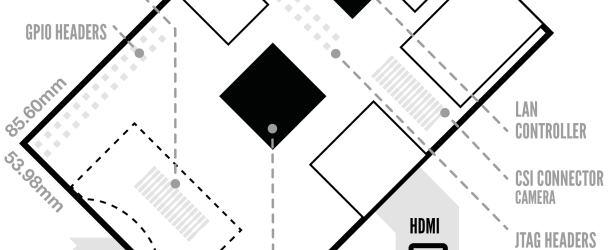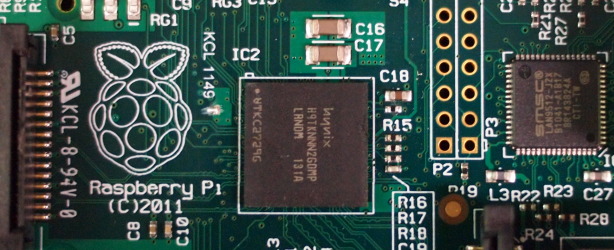Raspberry Pi: the modder's dream machine?
January 26, 2012 | 08:25
Companies: #arm #broadcom #raspberry-pi

Although it’s easy to be fooled by its small size - the same footprint as a standard credit card, if you ignore the overhanging components like the SD card slot and Ethernet port - the Raspberry Pi packs a surprising amount of power, thanks to some clever system-on-chip technology from Upton’s employer Broadcom.
At the heart of the device is a Broadcom BCM2835 system-on-chip, featuring an ARM11-based central processor running at 700MHz and a VideoCore IV graphics processor along with various input, output and multimedia processing subsystems. Originally designed for use in mobile phones and tablets, the relatively low clock speed of the chip belies a remarkably capable system: early beta boards have been demonstrated running full high-definition video playback and even Quake 3 without breaking sweat.
All the power in the world is no good without connectivity, of course, and here is where the story gets a little more complicated: borrowing a trick from Acorn Computers, the British microcomputing giant responsible for the BBC Micro, the Raspberry Pi will be made available in two flavours: Model A and Model B.
The A model is the cheap, headline-grabbing $25 version with basic functionality: along with the BCM2835 SoC is an SD card slot for storage, two USB 2.0 ports for peripherals, HDMI and composite RCA video output, an audio jack and on-board headers for soldering optional connectivity for cameras, displays and general purpose input/output devices, along with a somewhat scant 128MB of RAM. The Model B, by contrast, features everything the Model A has and adds in a 10/100 Ethernet port plus double the memory at 256MB for an additional $10 on the cost of the device.
For those looking to port their software to the platform - a process that Upton claims ‘should be fairly straightforward - I mean, from the general point of view it’s just a fairly old-fashioned PC’ - there is one minor caveat: the ARM chip at the heart of both models runs on the somewhat outdated ARMv6 instruction set, rather than the more modern ARMv7. As a result, certain software - including Ubuntu Linux and Adobe Flash Player - simply won’t run without significant work.
While it’s true that the specifications of the Raspberry Pi are unlikely to make even the cheapest of netbooks blush, it’s the price - at just $35 for the Model B - coupled with the low power draw and minuscule size that makes the devices so tempting from a modding perspective: featuring a micro-USB port for power, the entire device is passively cooled with nary a heatsink in sight and runs on a 5v, 1A power supply.
At the heart of the device is a Broadcom BCM2835 system-on-chip, featuring an ARM11-based central processor running at 700MHz and a VideoCore IV graphics processor along with various input, output and multimedia processing subsystems. Originally designed for use in mobile phones and tablets, the relatively low clock speed of the chip belies a remarkably capable system: early beta boards have been demonstrated running full high-definition video playback and even Quake 3 without breaking sweat.
All the power in the world is no good without connectivity, of course, and here is where the story gets a little more complicated: borrowing a trick from Acorn Computers, the British microcomputing giant responsible for the BBC Micro, the Raspberry Pi will be made available in two flavours: Model A and Model B.
The A model is the cheap, headline-grabbing $25 version with basic functionality: along with the BCM2835 SoC is an SD card slot for storage, two USB 2.0 ports for peripherals, HDMI and composite RCA video output, an audio jack and on-board headers for soldering optional connectivity for cameras, displays and general purpose input/output devices, along with a somewhat scant 128MB of RAM. The Model B, by contrast, features everything the Model A has and adds in a 10/100 Ethernet port plus double the memory at 256MB for an additional $10 on the cost of the device.
For those looking to port their software to the platform - a process that Upton claims ‘should be fairly straightforward - I mean, from the general point of view it’s just a fairly old-fashioned PC’ - there is one minor caveat: the ARM chip at the heart of both models runs on the somewhat outdated ARMv6 instruction set, rather than the more modern ARMv7. As a result, certain software - including Ubuntu Linux and Adobe Flash Player - simply won’t run without significant work.
While it’s true that the specifications of the Raspberry Pi are unlikely to make even the cheapest of netbooks blush, it’s the price - at just $35 for the Model B - coupled with the low power draw and minuscule size that makes the devices so tempting from a modding perspective: featuring a micro-USB port for power, the entire device is passively cooled with nary a heatsink in sight and runs on a 5v, 1A power supply.

MSI MPG Velox 100R Chassis Review
October 14 2021 | 15:04










Want to comment? Please log in.